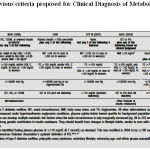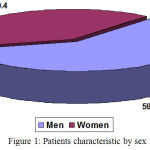Manuscript accepted on :November 20, 2017
Published online on: --
Plagiarism Check: Yes
Wira Gotera1 and Dewi Catur Wulandari2
1Endocrinology and Metabolic Division, Department of Internal Medicine, Udayana University School of Medicine / Sanglah General Hospital Denpasar, Bali, Indonesia.
2Endocrinology and Metabolic Consultant Program, Department of Internal Medicine, Udayana University School of Medicine / Sanglah General Hospital Denpasar, Bali, Indonesia.
Corresponding Author Email : wulandcwiyasa@gmail.com
DOI : https://dx.doi.org/10.13005/bpj/1296
Abstract
Patterns of lifestyle are changing very rapidly. This situation mainly hit the developing countries, especially food consumption leading westernization, coupled with the lack of physical activity. To evaluate the metabolic changes that occur to hotel workers who work in the center of tourism world, Bali. The number of hotel employees evaluated was 556 people, with 345 men (59.6%) and 234 women (40.4%). Average age 45 years old. Overweight with body mass index > 23, as many as 156 people (28.1%), obesity stage I, 180 people (32%), and obesity stage II 49 people (8.8%). Dyslipidemia as much as 544 people (97.8%), glucose tolerance disorder counted 98 people (17.6%), diabetes melitus 38 people (6.8%) and hypertension of 64 people (11.5%), and hyperuricemia as many as 137 people ( 24.7%). High rates of metabolic disturbance were found in hotel workers working in the center of tourism.
Keywords
Diabetes Mellitus; Dyslipidemia Hypertension; Metabolic Syndrome;Obesity;
Download this article as:| Copy the following to cite this article: Gotera W, Wulandari D. C. Metabolic Disorders Among Tourism Hotel Workers in Nusa Dua, Bali. Biomed Pharmacol J 2017;10(4). |
| Copy the following to cite this URL: Gotera W, Wulandari D. C. Metabolic Disorders Among Tourism Hotel Workers in Nusa Dua, Bali. Biomed Pharmacol J 2017;10(4). Available from: http://biomedpharmajournal.org/?p=18003 |
Introduction
The metabolic syndrome is a constellation of interrelated risk factors of metabolic origin — metabolic risk factors — that appear to directly promote the development of atherosclerotic cardiovascular disease (ASCVD).1 Metabolic syndrome are include conditions covering dyslipidemia, hypertension, and hyperglycemia, which can result in prophylactic and pro-inflammatory conditions.2 Someone who was diagnosed metabolic syndrome may have a two-fold increased risk of cardiovascular disease and a five fold increase in type 2 diabetes mellitus if they do not develop the syndrome.2 Several studies have shown that metabolic syndrome has an increased tendency in developing countries with dietary and change of lifestyle.
The pathogenesis of metabolic syndrome is complex, but the interaction between obesity, lifestyle, diet, and genetic factors is known to be a contributing factor. Research on metabolic syndrome is growing because the factors involved are associated with increased morbidity and mortality especially against cardiovascular risk.3 Compared with these risk factors, the occupation has not been widely discussed as a determinant of disease.
The need for physical activity, diet, and occupational stress varies among job groups. Some researchers have examined the role of work-related physical activity as an intermediary factor in the relationship between occupational and chronic illness. Research on the behavior and metabolic risk factors between industry and occupational groups including the hospitality industry is still rare.Hospitality is a fast growing industry in a developing country like Indonesia.
In the past, occupational health has focused more on specific physical and chemical hazards on the background of work. Less attention is paid to cardiovascular disease and other illnesses, which are often thought to be linked to a person’s lifestyle rather than his work. This applies to hospitality despite being an industry that produces and / or serves food including fast food associated with obesity. Risk factors for chronic illness among hotel workers need to be studied.4 In the past few years , several expert groups have attempted to set forth simple diagnostic criteria to be used in clinical practice to identify patients who manifest the multiple components of the metabolic syndrome.1
 |
Table 1: Previous criteria proposed for Clinical Diagnosis of Metabolic Syndrome1
|
The purpose of our study is to describe metabolic disorders among tourism hotel workers in Nusa Dua, Badung, Bali.
Method
All hotel employees working in one of the five-star hotels in the Nusa Dua Bali were examined for their overall health. The criteria used as a reference are National Cholesterol Education Program (NCEP) Adult Treatment Panel III (ATP III) for dyslipidemia and World Health Organization criteria for obesity.
Results Patient Characteristics
The number of hotel employees evaluated was 556 people, with 345 men (59.6%) and 234 women (40.4%) Average age 45 years.
 |
Figure 1: Patients characteristic by sex
|
Table 2: Description of Body Weight Classification Based on Body Mass Index
| Body Weight Classification | N | % |
| Normal | 171 | 31,1 |
| Overweight | 156 | 28,1 |
| Obesity stage I | 180 | 32,0 |
| Obesity stage II | 49 | 8,8 |
| Total | 556 | 100,0 |
Table 2 shown that more than half of employees with body mass index above normal. The most populations are employees with obesity stage 1 of 32%.
 |
Figure 2: Description Component of metabolic syndrome
|
Figure 2 shown that the most common component of metabolic syndrome found in employees were dyslipidemia (97.8%), followed by glucose intolerance (17.6%) and hypertension of 11.5%.
Discussion
This study shown the metabolic syndrome appearing at a median age of 45 years. This is consistent with the literature which states that the prevalence of metabolic syndrome increases with age, and more than 40% in those over 60 years.5 The most prominent in this study are obesity, followed by glucose intolerance, hypertension and diabetes. Obesity that causes free fatty acids increase in the blood will stimulate the release of cytokines or metabolic products that can reduce insulin sensitivity. These cytokines include proinflammatory cytokines, procoagulants, peptide inflamation, and angiotensinogen.
The products of fat cells and the increase in free fatty acids in plasma are responsible for many metabolic diseases, such as diabetes, atherosclerotic cardiovascular disease, dyslipidemia (one of which is characterized by a decrease in HDL cholesterol), gout, and hypertension.6 One study in India resulted in a high prevalence of obesity even at age 35, requiring immediate interventions aimed at preventive.
Workplace interventions have proven to be effective in altering some positive behaviors such as smoking, physical activity, and eating patterns.3 By early detection and early intervention can prevent premature death, reduce comorbidity, and minimize maintenance costs. Some risk factors that may affect the incidence of metabolic syndrome in this case need to be studied further. The study of hotel workers in India has several risk factors for metabolic syndrome, including smoking, drinking alcohol, physical activity, occupation, and diet. Smoking behavior is found in about one-third of male workers, whereas alcohol drinkers in hotel workers appear to show higher statistics than the general community of the country.
Working in places such as food preparation, food service, and security have poor behavioral traits such as pre-serving food tests, adding food additives and excessive alcohol consumption especially to security and food service.3
Shift work is also known to have an effect on the circadian rhythm Can lead to metabolic syndrome-related disorders.7 Unfortunately in this study did not look for risk factors for metabolic syndrome, so it is expected that future studies can be the basis or reference for finding risk factors for metabolic syndrome, especially in Bali.
Acknowledgment
Authors of the current article take this opportunity to thanks to all of participants who warmly co-operated in this research program.
Conflict of Interests
The authors declare that there is no conflict of interests regarding the publication of this paper.
References
- Grundy S. M., Cleeman J. I., Daniels S. R., Donato K. A., Eckel R. H., Franklin B. A et al. Diagnosis and Management of The Metabolic Syndrome. An American Heart Association National Heart, Lung and Blood Institute Scientific Statement. Circulation. 2005;112(17):2735–52. DOI 10.1161/ CIRCULATIONAHA. 105.1694042.
- Grundy B. C. Metabolic Syndrome Pandemic. Arterioscler Thromb. Vasc Biol. 2008;28(3):629-36.
- Nandi S. S., Dynamic S. V., Dhumne U. L. Occurrence of Metabolic Syndrome with Relation to Job Profile Among Mine Employees. J Obes Metab Res. 2016;3:32-6.4.
- Gawde N. C.,Kurlikar P. R . Chronic Disease Risk Factors Among Hotel Workers. Indian J Occup Environ Med. 2016;20(1):14-20.5.
- Rochmah W. Z., Prabandari Y. S., Setyawati L. K. Prevalensi Sindrom Metabolik Pada Work Enterprises. Journal Kesehatan. National Society. 2014;9:2:113-120.6.
- Ervin R. B. Prevalence of Metabolic Syndrome Between Adults 20 years of Age and Over, by Sex, Age, Race, Ethnicity, and Body Mass Index. United States. 2003-2006. Nat Health Stat Reports. 2009;13:1-8.
- Ye H. H., Jeong J. U., Jeon M. J., Sakong J. The Association Between Shift Work and The Metabolic Syndrome in Female Workers. Ann Occup Environ Med. 2013;25:33.
CrossRef







